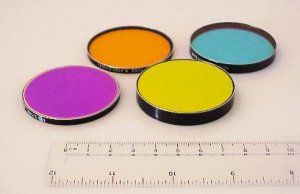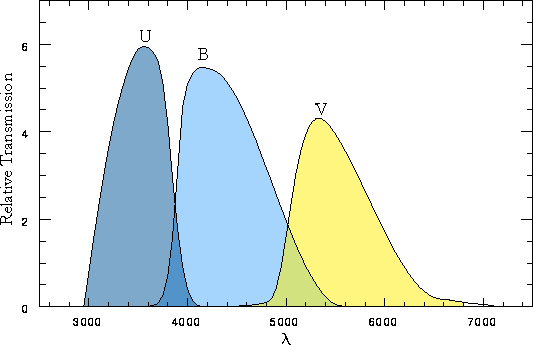Filters

Credit: LT
Cameras on telescopes measure the amount of light emitted by a star. However, most cameras are also not able to measure colour at the same time as brightness.
Colour is useful for astronomy. For example, it can tell us how hot an object like a star is. It can also tell us if things are moving towards us or away from us. Often the colour of a star will also tell us roughly how old it is.
To measure different wavelengths of light, we use special coloured glass filters in front of the camera. These only let through light of a particular range of colours, like red, green or blue.
We can use this technique to work out the colour of the objects. For example, a blue star will be brighter in a blue filter image than in a red one. We can quantify the colour of a star by measuring the brightness at two different wavelengths. This gives us a colour index value.
Filters on professional telescopes are carefully made to let through an exact range of wavelengths. This allows us to compare images made by different telescopes easily. Sometimes the best filter can change depending on the conditions at the time of the observation. In the Go Observing system, a special computer programme is used to decide on the best filter. You can look in the FITS header to find out which filter was used during your observation.
Telescope filters come in two main types: broad-band filters and narrow-band filters.
Broad-band filters let through optical light which has a wavelength larger than about 100 nanometres (n).
Examples of broad-band filters:
- U – ultraviolet filter, centred at 360 nm
- B – blue filter, centred at, 440 nm, good for finding hot stars
- V – visual" filter, centred at 550 nm, lets through most of the yellow and green light that our eyes can see
- R – red filter, centred at 700 nm, often used to look at cooler stars
- I – infra-red filter, centred at 900 nm
Narrow-band filters are usually used to measure light with a wavelength of about 5 nanometres, this is known as the Ha or H alpha line. This is a particular shade of red made when hydrogen gets hot. Hydrogen makes up most of the Universe we can see. This filter is a good one to use when you are looking for hot gas. We get hot gas in areas of space where stars are being born.
There are also filters called neutral density filters. These are not coloured but grey. These filters actually block out a fraction of all colours of light. This means you can take images of very bright things like the Moon or planets.

Credit: Dale Gary (NJIT)

